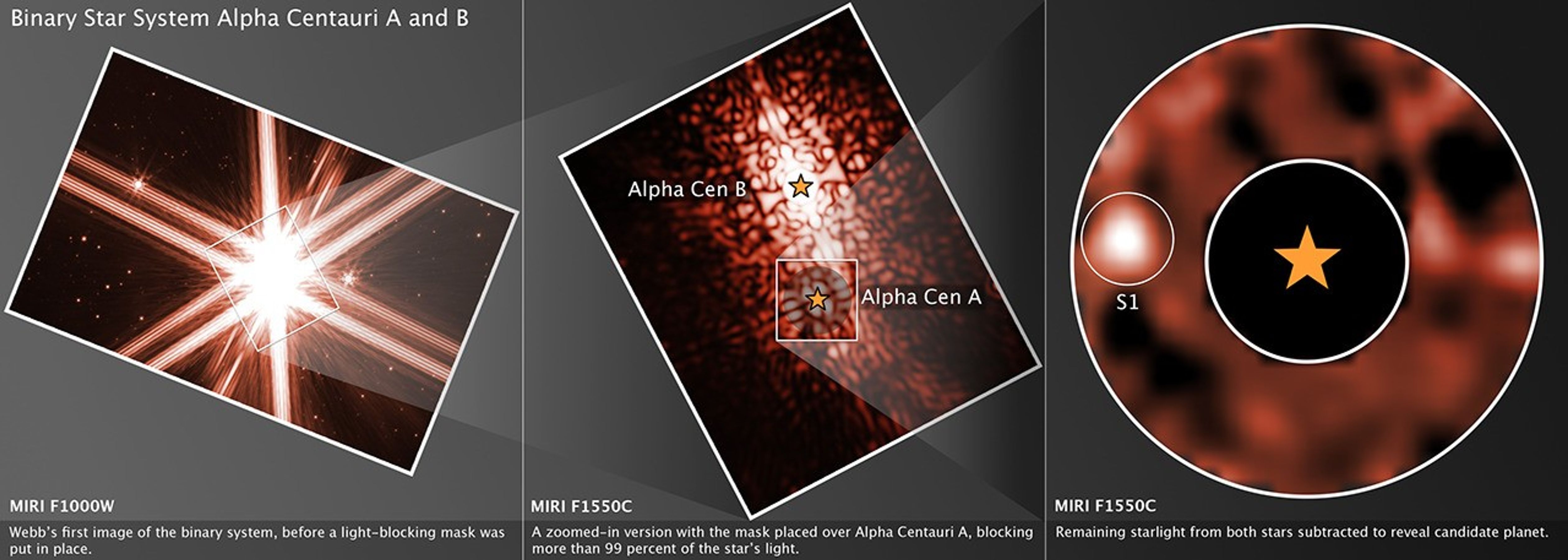1 min read
Alpha Centauri 3 Panel (Webb MIRI Image Detail)

This three-panel image captures NASA’s James Webb Space Telescope’s observational search for a planet around the nearest Sun-like star, Alpha Centauri A. The initial image shows the bright glare of Alpha Centauri A and Alpha Centauri B, and the middle panel then shows the system with a coronagraphic mask placed over Alpha Centauri A to block its bright glare. However, the way the light bends around the edges of the coronagraph creates ripples of light in the surrounding space. The telescope’s optics (its mirrors and support structures) cause some light to interfere with itself, producing circular and spoke-like patterns. These complex light patterns, along with light from the nearby Alpha Centauri B, make it incredibly difficult to spot faint planets. In the panel at the right, astronomers have subtracted the known patterns (using reference images and algorithms) to clean up the image and reveal faint sources like the candidate planet.
About the Object
- R.A. PositionR.A. PositionRight ascension – analogous to longitude – is one component of an object's position.14:39:37.08
- Dec. PositionDec. PositionDeclination – analogous to latitude – is one component of an object's position.-60:48:56.29
- ConstellationConstellationOne of 88 recognized regions of the celestial sphere in which the object appears.Centaurus
- DistanceDistanceThe physical distance from Earth to the astronomical object. Distances within our solar system are usually measured in Astronomical Units (AU). Distances between stars are usually measured in light-years. Interstellar distances can also be measured in parsecs.4 light-years
About the Data
- Data DescriptionData DescriptionProposal: A description of the observations, their scientific justification, and the links to the data available in the science archive.
Science Team: The astronomers who planned the observations and analyzed the data. "PI" refers to the Principal Investigator.This image was created with Webb data from proposal: 1618 (C. Beichman). Image processing: Joseph DePasquale (STScI).
- InstrumentInstrumentThe science instrument used to produce the data.MIRI
- Exposure DatesExposure DatesThe date(s) that the telescope made its observations and the total exposure time.July-August, 2024
- FiltersFiltersThe camera filters that were used in the science observations.F1000W, F1500C
- Object NameObject NameA name or catalog number that astronomers use to identify an astronomical object.Alpha Centauri AB
- Object DescriptionObject DescriptionThe type of astronomical object.Binary star system
- Release DateAugust 7, 2025
- Science ReleaseNASA’s Webb Finds New Evidence for Planet Around Closest Solar Twin
- CreditNASA, ESA, CSA, Aniket Sanghi (Caltech), Charles Beichman (NExScI, NASA/JPL-Caltech), Dimitri Mawet (Caltech); Image Processing: Joseph DePasquale (STScI)

These images were acquired by the MIRI instrument on the James Webb Space Telescope. The color results from assigning a warm/red color map to a monochromatic (grayscale) image.
Related Images & Videos

Alpha Centauri 3 Panel (DSS, Hubble, Webb)
This image shows the Alpha Centauri star system from several different ground- and space-based observatories: the Digitized Sky Survey (DSS), NASA’s Hubble Space Telescope, and NASA’s James Webb Space Telescope. Alpha Centauri A is the closest Sun-like star to Earth.
Share
Details
Laura Betz
NASA’s Goddard Space Flight Center
Greenbelt, Maryland
laura.e.betz@nasa.gov
NASA, ESA, CSA, Aniket Sanghi (Caltech), Charles Beichman (NExScI, NASA/JPL-Caltech), Dimitri Mawet (Caltech)
Joseph DePasquale (STScI)































